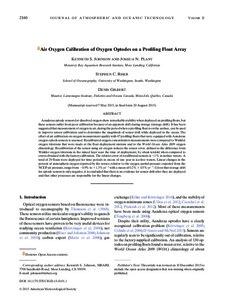| dc.contributor.author | Johnson, Kenneth S. | |
| dc.contributor.author | Plant, Joshua N. | |
| dc.contributor.author | Riser, Stephen C. | |
| dc.contributor.author | Gilbert, Denis | |
| dc.date.accessioned | 2019-05-13T20:35:35Z | |
| dc.date.available | 2019-05-13T20:35:35Z | |
| dc.date.issued | 2015 | |
| dc.identifier.citation | Johnson, K.S.; Plant, J,N,; Riser, S.C.and Gilbert, D. (2015) Air Oxygen Calibration of Oxygen Optodes on a Profiling Float Array. Journal of Atmospheric and Oceanic Technology, 32, pp.2160–2172. DOI: https://doi.org/10.1175/JTECH-D-15-0101.1 | en_US |
| dc.identifier.uri | http://hdl.handle.net/11329/927 | |
| dc.identifier.uri | http://dx.doi.org/10.25607/OBP-468 | |
| dc.description.abstract | Aanderaa optode sensors for dissolved oxygen show remarkable stability when deployed on profiling floats, but these sensors suffer from poor calibration because of an apparent drift during storage (storage drift). It has been suggested that measurement of oxygen in air, during the period when a profiling float is on the surface, can be used to improve sensor calibration and to determine the magnitude of sensor drift while deployed in the ocean. The effect of air calibration on oxygen measurement quality with 47 profiling floats that were equipped with Aanderaa oxygen optode sensors is assessed. Recalibrated oxygen concentration measurements were compared to Winkler oxygen titrations that were made at the float deployment stations and to the World Ocean Atlas 2009 oxygen climatology. Recalibration of the sensor using air oxygen reduces the sensor error, defined as the difference from Winkler oxygen titrations in the mixed layer near the time of deployment, by about tenfold when compared to errors obtained with the factory calibration. The relative error of recalibrated sensors is <1% in surface waters. A total of 29 floats were deployed for time periods in excess of one year in ice-free waters. Linear changes in the percent of atmospheric oxygen reported by the sensor, relative to the oxygen partial pressure expected from the NCEP air pressure, range from −0.9% to +1.3% yr−1 with a mean of 0.2% ± 0.5% yr−1. Given that storage drift for optode sensors is only negative, it is concluded that there is no evidence for sensor drift after they are deployed and that other processes are responsible for the linear changes. | en_US |
| dc.language.iso | en | en_US |
| dc.rights | Attribution 4.0 | * |
| dc.rights.uri | http://creativecommons.org/licenses/by/4.0/ | * |
| dc.subject.other | Dissolved oxygen | en_US |
| dc.title | Air Oxygen Calibration of Oxygen Optodes on a Profiling Float Array. | en_US |
| dc.type | Journal Contribution | en_US |
| dc.description.refereed | Refereed | en_US |
| dc.format.pagerange | pp.2160-2172 | en_US |
| dc.identifier.doi | 10.1175/JTECH-D-15-0101.1 | |
| dc.subject.parameterDiscipline | Parameter Discipline::Chemical oceanography | en_US |
| dc.bibliographicCitation.title | Journal of Atmospheric and Oceanic Technology | en_US |
| dc.bibliographicCitation.volume | 32 | en_US |
| dc.description.eov | Oxygen | en_US |
| dc.description.bptype | Standard Operating Procedure | en_US |
| obps.contact.contactemail | johnson@mbari.or | |
| obps.resourceurl.publisher | https://journals.ametsoc.org/doi/pdf/10.1175/JTECH-D-15-0101.1 | en_US |
 Repository of community practices in Ocean Research, Applications and Data/Information Management
Repository of community practices in Ocean Research, Applications and Data/Information Management

